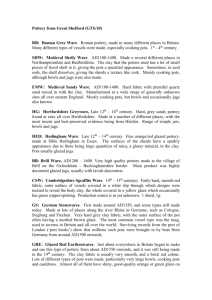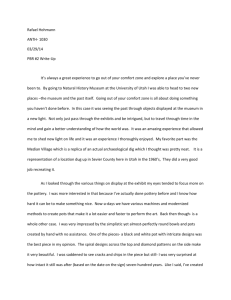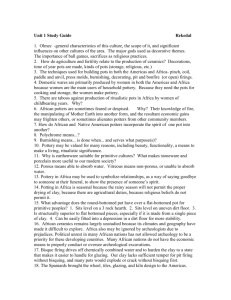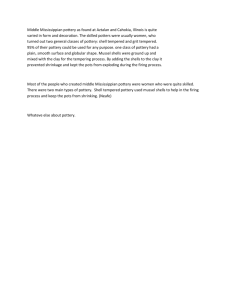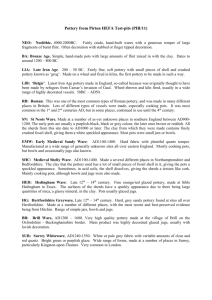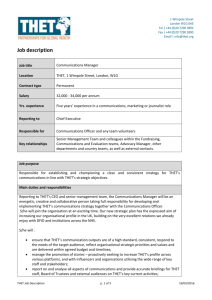Pottery from Field-Walking, Bures, Suffolk
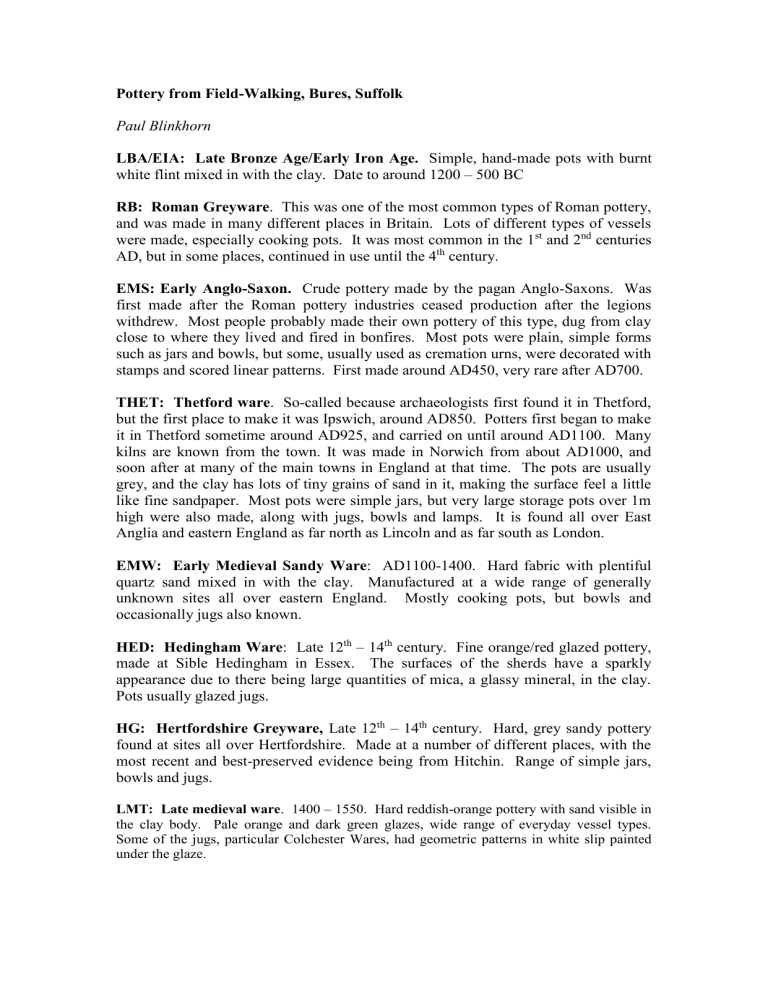
Pottery from Field-Walking, Bures, Suffolk
Paul Blinkhorn
LBA/EIA: Late Bronze Age/Early Iron Age.
Simple, hand-made pots with burnt white flint mixed in with the clay. Date to around 1200 – 500 BC
RB: Roman Greyware . This was one of the most common types of Roman pottery, and was made in many different places in Britain. Lots of different types of vessels were made, especially cooking pots. It was most common in the 1 st
and 2 nd
centuries
AD, but in some places, continued in use until the 4 th
century.
EMS: Early Anglo-Saxon.
Crude pottery made by the pagan Anglo-Saxons. Was first made after the Roman pottery industries ceased production after the legions withdrew. Most people probably made their own pottery of this type, dug from clay close to where they lived and fired in bonfires. Most pots were plain, simple forms such as jars and bowls, but some, usually used as cremation urns, were decorated with stamps and scored linear patterns. First made around AD450, very rare after AD700.
THET: Thetford ware . So-called because archaeologists first found it in Thetford, but the first place to make it was Ipswich, around AD850. Potters first began to make it in Thetford sometime around AD925, and carried on until around AD1100. Many kilns are known from the town. It was made in Norwich from about AD1000, and soon after at many of the main towns in England at that time. The pots are usually grey, and the clay has lots of tiny grains of sand in it, making the surface feel a little like fine sandpaper. Most pots were simple jars, but very large storage pots over 1m high were also made, along with jugs, bowls and lamps. It is found all over East
Anglia and eastern England as far north as Lincoln and as far south as London.
EMW: Early Medieval Sandy Ware : AD1100-1400. Hard fabric with plentiful quartz sand mixed in with the clay. Manufactured at a wide range of generally unknown sites all over eastern England. Mostly cooking pots, but bowls and occasionally jugs also known.
HED: Hedingham Ware : Late 12 th
– 14 th
century. Fine orange/red glazed pottery, made at Sible Hedingham in Essex. The surfaces of the sherds have a sparkly appearance due to there being large quantities of mica, a glassy mineral, in the clay.
Pots usually glazed jugs.
HG: Hertfordshire Greyware, Late 12 th – 14 th century. Hard, grey sandy pottery found at sites all over Hertfordshire. Made at a number of different places, with the most recent and best-preserved evidence being from Hitchin. Range of simple jars, bowls and jugs.
LMT: Late medieval ware . 1400 – 1550. Hard reddish-orange pottery with sand visible in the clay body. Pale orange and dark green glazes, wide range of everyday vessel types.
Some of the jugs, particular Colchester Wares, had geometric patterns in white slip painted under the glaze.
GRE: Glazed Red Earthenwares : Fine sandy earthenware, usually with a brown or green glaze, usually on the inner surface. Made at numerous locations all over
England. Occurs in a range of practical shapes for use in the households of the time, such as large mixing bowls, cauldrons and frying pans. It was first made around the middle of the 16th century, and in some places continued in use until the 19th century.
ES: English Stoneware: Very hard, grey fabric with white and/or brown surfaces.
First made in Britain at the end of the 17 th
century, became very common in the 18 th and 19 th
century, particularly for mineral water or ink bottles and beer jars.
CR: Creamware . This was the first pottery to be made which resembles modern
‘china’. It was invented by Wedgewood, who made it famous by making dinner surfaces for some of the royal families of Europe. Made between 1740 and 1880, it was a pale cream-coloured ware with a clear glaze, and softer than bone china. There were lots of different types of pots which we would still recognise today: cups, saucers, plates, soup bowls etc. In the 19 th century, it was considered to be poor quality as better types of pottery were being made, so it was often painted with multicoloured designs to try and make it more popular.
VIC: ‘Victorian’.
A wide range of different types of pottery, particularly the cups, plates and bowls with blue decoration which are still used today. First made around
AD1800
All fieldwalking was undertaken in ‘Tile Field’, to the east of Bures St Mary, centred on TL 592554 – 234026. This was undertaken over two separate days, one of the 13 th
March 2011 and the other on the 24 th
March 2011.
Pottery Occurrence
BA/EIA RB E/MS THET EMW HED HG LMT GRE ES CR VIC
Trans Stint No Wt No Wt No Wt No Wt No Wt No Wt No Wt No Wt No Wt No Wt No Wt No Wt
0 20-30
0 30-40 1 23
2 21
0 40-50
0 50-60
0 80-90
0 90-100
10 20-30
1 5
1 6
1 20
1 2
2 14
10 50-60
10 90-100
20 40-50
20 90-100
30 0-10
30 10-20
30 30-40
30 40-50
30 70-80
30 80-90
40 0-10
40 10-20
40 40-50
40 80-90
50 0-10
1 1
2 6
1 2
1 11
50 10-20
50 20-30
50 50-60
60 10-20
1 23
60 20-30
60 40-50
1 57
60 60-70 3 24 3 18
60 70-80 1 5
60 80-90
60 90-100 1 14
1
2
1
1
1 10
1
2
1
4
7
8
2
9
8
3
1 6
1
1
1
8
8
3
1 7
1 27
1 15
1 7
1 1
1 2
2 6
1 1
90 40-50
90 70-80
90 90-100
100 10-20
100 80-90
110 0-10
110 30-40
110 70-80
110 80-90
110 90-100
120 10-20
120 40-50
120 70-80
120 80-90
120 90-100
130 50-60
130 60-70
130 90-100
140 0-10
140 10-20
1 5
1 2
2 27
1 61
1 3 1 4
1 3
1 6
1 4
1 2
1 6
1 4
1 15
2 7
1 5
3 9
1 2
1
2
21
14
2 33
2 36
3 22 2 13
1 11
2 5
1 1
1 4
5 45
1 6
1 11
1 6
BA/EIA RB E/MS THET EMW HED HG LMT GRE ES CR VIC
Trans Stint No Wt No Wt No Wt No Wt No Wt No Wt No Wt No Wt No Wt No Wt No Wt No Wt
140 30-40
140 90-100
1 9 1
2
15
6
150 0-10
150 10-20
150 40-50
150 50-60
160 30-40
2 19
1
1
2
3
2
8
1 4
1 10
160 90-100
170 10-20
170 20-30
170 80-90
190 80-90
210 0-10
210 30-40
1 2
2 12
1 1
1 42
3 12
1 4
1 2
1 2
210 60-70 1 1 1 4
230 30-40
230 60-70
230 80-90
1
1
4
20
240 50-60
270 40-50
290 70-80
290 80-90
1
1
10
7
Not Bold dates to 13 th
March 2011
Bold dates to 24 th
March 2011
1 6
1 1
1 5
1 12


